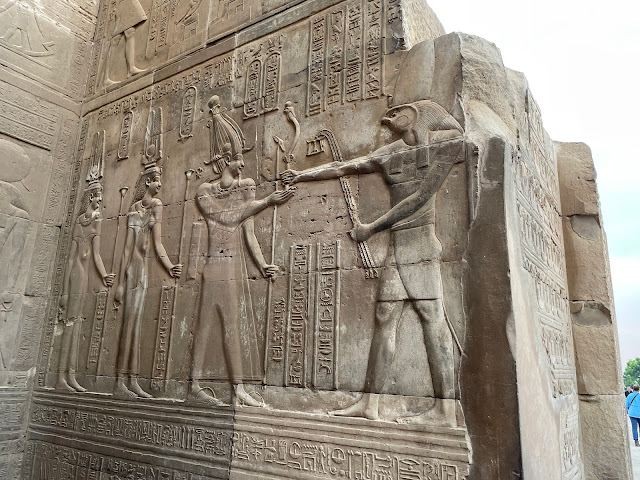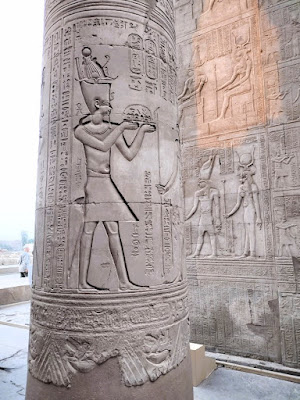Had our ship ported near Kom Ombo at the time of Greek Ptolemaic rule, we would have found African elephants cooling off in the Nile River.
Military elephants were trained in the area.
A greater precaution would have been taken due to the presence of fierce crocodiles.
The great Aswan Dam built in the 20th Century eliminated the dangers posed by crocodiles at Kom Ombo, but the Temple honoring Sobek, a god with a crocodile head, still stands.
Actually, it is a dual Temple of Sobek and Horus the Elder, aka Harwer and several other names.
I was under the impression that Horus the Elder was the adult version of the younger Horus that was worshipped in ancient Egypt at the Temple of Horus at Edfu, but apparently based on one version of a family tree, Harwer may have been Horus's uncle.
This begs the question why does his uncle have a falcon head like Horus, but Horus's father Osiris --- based on The Lion King-like legend we heard at Edfu --- doesn't?
Then again, Horus's mother Isis was not only his uncle's sister but also her husband's sister, so perhaps the apple didn't fall far from the tree after all...or something.
Anyway, to quote Psych's Sean Spencer out of context, "I've heard it both ways."
The center of attention at the Temple at Kom Ombo for our excursion was the crocodile-headed god Sobek. He was supposed to possess protective magic against the dangers of the Nile.
In an age when crocodiles could clearly maim or kill anyone who ventured too close to the Nile at meal time, I suppose it made sense for these primitive people to want a beast-headed god like Sobek on their side to protect them.
When we arrived at Kom Ombo, we found a long line, prompting our guide Fawzy to exclaim several times that he had never seen a crowd that large. He took several photos to share with his fellow guides.
A section of wall features engraved images of early medical tools including forceps, scalpels and medical bottles. There was a legend we heard at Edfu about Horus having his eyes plucked out by Seth and having one repaired, which he gave to his father Osiris to use in the afterlife.
Ancient Astronaut theorists have taken this myth and the story of Osiris being re-assembled by his wife Isis as literal.
Regardless of more far-fetched hypotheses, Egyptians seem to have had access to advanced knowledge of how to use a doctor's trayful of medical equipment. The legend of the Eye of Horus had an associated symbol of the same name which has morphed into the Rx symbol used by modern drugstores.
Too many other tour groups were clumped ahead of us in the line, resulting in an estimated 30-minute wait in line.
Fawzy said those of us interested could possibly get close enough to view it on their own by meandering individually past the groups, but he didn't want to make the whole group stand in a line that might make us late for dinner.
While he didn't say this, I would guess over the years Fawzy has learned to never make a cruiser late for a meal or he may be nose-to-nose with a form of humanoid crocodile.
A dentist in our group --- whose yellow shirt makes him quite noticeable in the photo at the top -- had been anticipating seeing these tools as a highlight of the site --- so he and I weaved our way around the groups and got close enough to see the engravings before it was too dark.
To the left side of the array of medical implements --- which definitely seem to be some that doctors still use still use --- are two women sitting on birthing chairs.
Based on size being a depiction of status in Egyptian art, the doctor, on the right side was perhaps a god but in any case certainly a revered man. He wields the Ankh, which is the Egyptian Key to Life.
The Kom Ombo Temple, like Edfu, was built by the Ptolemies, with construction beginning under Pharaoh Ptolemy VI and updated through the generation of Ptolemy XIII.
There is a rare engraved image of the last Ptolemaic Pharaoh, Cleopatra VII (yes, THE Cleopatra), in the main temple, standing behind her brother Ptolemy VIII who is being blessed by a falcon-headed god, which I would guess is Horus the Elder, given this was his Temple.
Roman Emperors also made their mark on Kom Ombo in the Roman Era that succeeded the last Pharaoh's reign, adding some temples and artwork.
The most distinctive part of the Temple at Kom Ombo was the Crocodile Museum, featuring mummified crocodiles.
Julie had been lured by the air-conditioning to get there before me, and she pointed out everything she had found interesting.
The midday river cruise in between Edfu and Kom Ombo made this day feel relatively relaxed, which was just as well, because the next day would be a long one.














































No comments:
Post a Comment